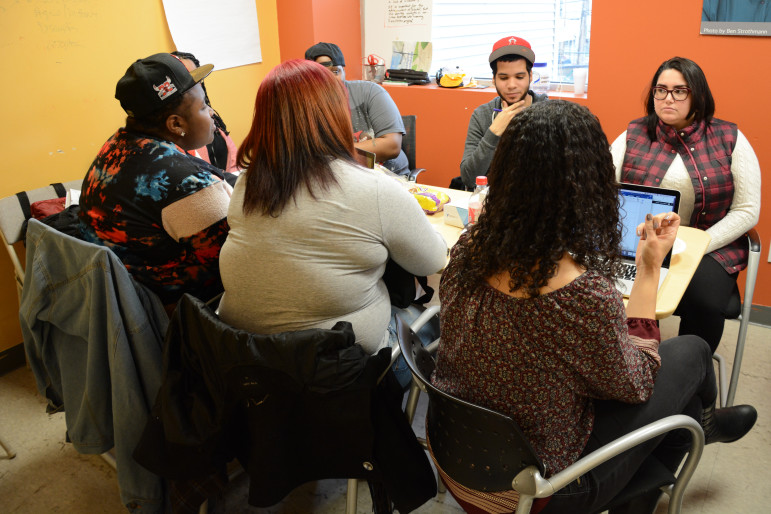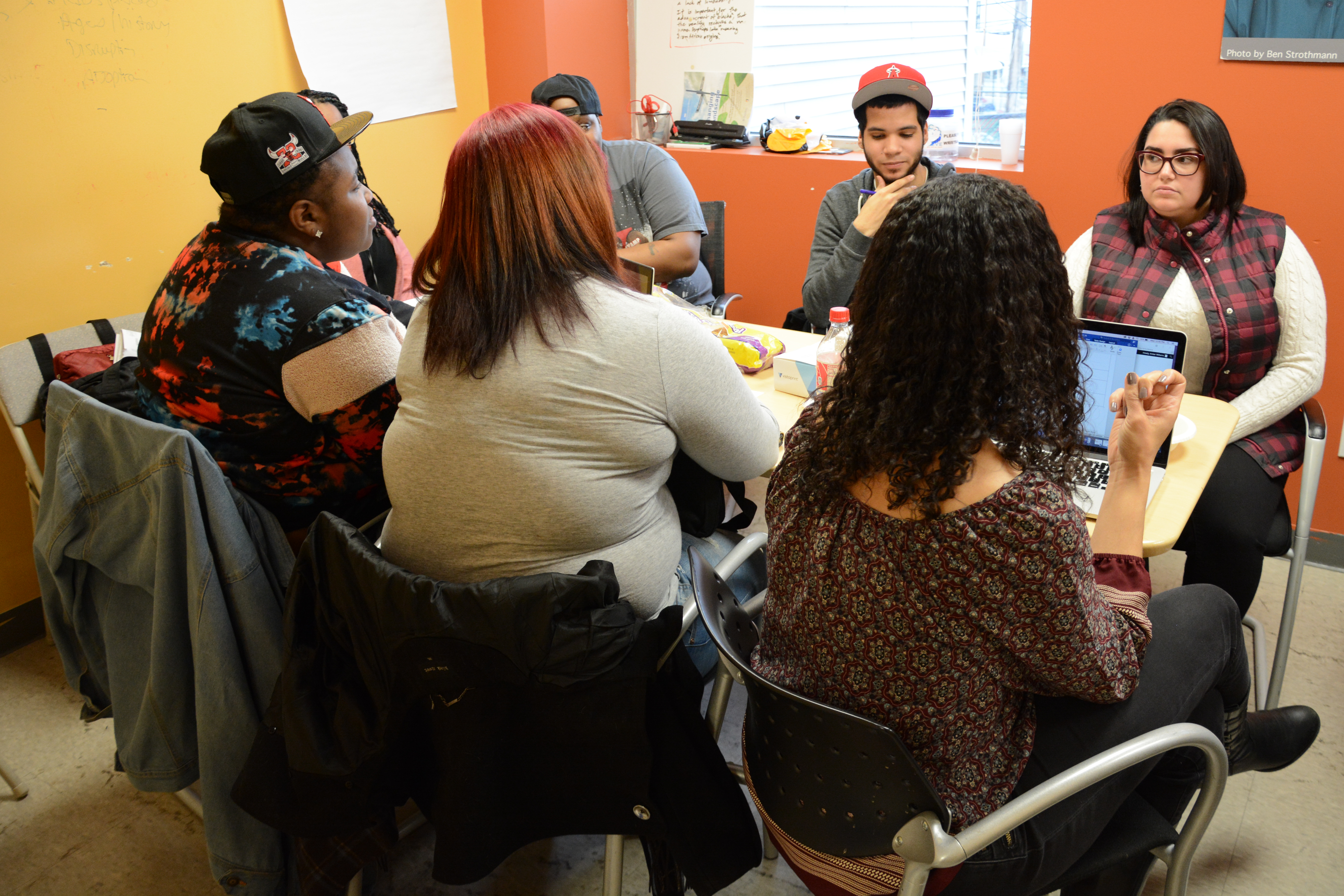
Photos by Gwen McClure
Kathy Rando dropped out of high school as a foster child but with a new foster mother, who later adopted her, she got her GED and an associate’s degree.
Before the Allegheny County Department of Human Services set up a data-sharing program back in 2009 with the Pittsburgh Public School District, the department “lacked a clear picture” of how children in foster care were faring in school.
But now, the data-sharing program has “emerged as a catalyst for gaining deeper insight into those students and eroding the barriers that tend to discourage collaboration” between child welfare and school workers, according to a 2015 brief from the department (second on list).
Improving educational outcomes for students in foster care is one of the goals of the Every Student Succeeds Act (ESSA), signed into law in December.
ESSA requires states to track high school graduation rates for children in foster care, including four-year adjusted cohort graduation rates, and, as states see fit, graduation rates for students who take longer than four years to finish high school.
Creating a clearer picture for foster kids
Advocates say the requirement for states to start tracking graduation rates and other key outcomes for children in foster care is a critical development that should provide a clearer picture of the challenges such children face in staying on track to receive their diplomas.
“Assuming that these reporting provisions of ESSA are actually implemented well, which is by no means assured and will undoubtedly take time, I believe that it will ultimately have an impact on graduation rates for youth in foster care,” said Mark Courtney, a professor in the School of Social Service Administration at the University of Chicago and an expert on outcomes for children in foster care.
“Up to now, child welfare agencies and schools could get away with not paying much attention to the school performance of foster youth because there was no publicly available data on the subject,” Courtney said. “Routinely and publicly shedding light on how these youth fare educationally will empower advocates to push for increased attention to the educational needs of foster youth by schools and the child welfare system.”
Advocates believe tracking high school graduation rates will lead to positive outcomes at the postsecondary level.
As Maddy Day, director of outreach and training at the Center for Fostering Success at Western Michigan University — which works to improve college graduation among young adults aging out of the foster care system — said: “Tracking high school graduation rates will better allow us to understand how young people from foster care move through the education-to-career pipeline and thus provide education and child welfare professionals the opportunity to provide targeted services to these students in an effort to increase college access and success.
“Furthermore, by tracking high school graduation rates, colleges and universities will be better able to understand the scope and needs of this student population as they make their way into higher-education settings,” Day said.
She also said ESSA’s emphasis keeping students in the same school despite changes in foster care placement is “a significant factor in future success in higher education for students from foster care.”
Using data to reform systems
By several accounts, the Allegheny County DHS’ data-sharing initiative has been a success.
Maura McInerney, senior attorney at the Education Law Center in Philadelphia, a collaborator in the data-sharing initiative, says county caseworkers and school workers have been using the program to achieve more school stability for children placed in out-of-home care — a population for whom school disruptions are all too common.
“Like all information, it’s only meaningful if it informs effective decision-making,” McInerney said. “They … really used that information for their decision-making at the school level and child welfare level, and providing that information to judges when they go into court on a dependency case.”
School stability has improved for these children since the program began. For instance, while 45 percent of Pittsburgh Public School children had been subjected to school changes after being placed in foster care in 2009, by 2012 the percentage dropped to 27 percent (a DHS brief says the increased stability “cannot be attributed to a single initiative, policy or practice”).
“Rather, it is likely the result of a confluence of factors that place a greater emphasis on improving school stability for children and youth in the child welfare system,” states the brief, titled “The Impact of Child Welfare System Involvement on School Stability: An Evaluation of Pittsburgh Public School Students.”
For all the positive things that can be said about the program, there is one critical piece of information the system does not routinely collect, like many others that track children in foster care nationwide: high school graduation rates.
[Related: New York Tries New Ways to Increase Stability for Kids in Foster Care]
Tracking graduation rates
The rates in Allegheny County — similar to graduation rates for children in foster care throughout the country — show that youth in foster care graduate at less than half the rate of their peers. That raises questions about the efficacy of the program that is supposed to enable caseworkers and school officials to develop what the report calls “better strategies to improve outcomes for children served by both systems.”
While 66 percent of all Pittsburgh public school students who were high school freshmen in the 2010-11 school year graduated in the 2013-14 school year, among those who were in foster care, only 31 percent graduated, according to DHS.
“Graduation rates have always been an issue of interest to DHS, but the community partnership that drives the DHS/school district work chose other very important issues, like attendance and school moves, to focus on first,” said Elaine Plunkett, a communications specialist for DHS. That’s why the program does not track the number of children in its care who got a diploma, she said.

Kathy Rando meets with colleagues in a weekly staff meeting at You Gotta Believe, where she works as a youth advocate.
Graduation rates would not be “actionable” information since it is based on a milestone achieved at the end of a student’s K-12 career, she said; while the program is meant to inform decision-making while students are still in school.
A variety of factors can depress graduation rates for foster children, such as running away, becoming incarcerated or even transferring to another school district or getting a GED — all of which may be coded as “dropping out,” Plunkett said.
“It should be noted that very few child welfare systems have that data integration, let alone the analytic capacity to run it at all,” she said.
Be that as it may, the situation in Allegheny County shows how even when school stability is increased, graduation rates may not necessarily follow.
Or, as Janet Stotland, former executive director of the Education Law Center, warned in a 2014 report: “You could have school stability but still have poor school performance.”
“The real goal is for kids in the system to come out of the education system with the skills to succeed,” Stotland told The Annie E. Casey Foundation for a report.
McInerney expressed similar optimism.
“I think that it is a sea change that will make a huge difference because it will highlight the needs of this very vulnerable population and allow states to identify the needs of children in foster care,” she said. “If you link it to your K-12 system, you can look at a lot of other indicators. Is there a need for targeted remedial support? Or are they graduating but doing it in five years?”
McInerney said the law center helped push for the extended-year adjusted cohort rate because sometimes children in foster care may take longer than four years to graduate due to the disruptions in their education. For instance, a student in foster care may have earned credits or taken a required course in one school district that may not always be recognized by receiving school districts, advocates say. That’s one of the reasons behind pushes to secure more foster homes in school districts that have higher rates of placements in out-of-home care.
Holding schools accountable
Nationally, only about 50 percent of foster children graduate from high school by 18, according to a national fact sheet on educational outcomes. There are currently about 415,000 children in foster care in the U.S. The latest high school graduation rates for all children is about 82 percent.
The optimism that surrounds the Every Student Succeeds Act may sound similar to when the Fostering Connections to Success and Increasing Adoptions Act of 2008 passed. However, advocates say there is a key difference.
While the Fostering Connections Act told child welfare agencies to coordinate with education agencies to provide assurance of school stability in the child welfare case plan — and to consider the proximity of the child’s original school when doing placements — the problem was “there was no corollary on the education side,” said Katherine Burdick, staff attorney with the Philadelphia-based Juvenile Law Center.
“So where this education law was telling child welfare agencies they had to have school stability, there was nothing telling education agencies they had to do the same thing,” she said.
Scott Hollander, executive director of KidsVoice, a Pittsburgh-based organization that advocates for nearly 3,000 children in the child welfare system in Allegheny County, says it’s important to hold schools accountable for how well they serve children who have been removed from their homes.
He pointed to a recent class-action lawsuit his organization filed on behalf of children in foster care who were living in the Auberle group home in McKeesport, Pennsylvania. They were not allowed to attend McKeesport area schools but were instead segregated in a separate building. There, seventh- through 12th-graders were all educated in the same classroom and not given the same resources and extracurricular activities as other McKeesport students.
“The Auberle children did not receive textbooks, only worksheets, had almost no computer access and were not provided access to the library, AP courses or science labs,” Hollander noted.
But less than two months after the lawsuit was filed, the children of Auberle were educated with other children in the district.
“One of the greatest outcomes of this case is that once the Auberle students attended the regular classrooms more than 30 percent of the students residing at Auberle made the honor roll, which is higher than the overall district percentage,” Hollander said.
Will ESSA help?
Despite the optimism that things will get better for foster children under ESSA, serious questions remain about implementing the provisions that relate to tracking graduation rates for youth in foster care.
The U.S. Department of Education is currently working on guidance for states.
For instance, questions remain about whether to count only children who are in foster care at the time they should be graduating, or children who have had contact with the child welfare system at any time, or some measure in between.
The federal government has been cognizant of the need to track graduation rates for foster children for some time.
For instance, the Government Accountability Office recommended in 2014 that the Department of Health and Human Services begin to include educational data in the Adoption and Foster Care Analysis and Reporting System. HHS is currently reviewing public input on the matter, still working to issue a final rule later this year.
One national system that does shine light on educational outcomes for children in foster care is the National Youth in Transition Database (NYTD). According to NYTD’s latest brief, by age 19 approximately 55 percent of young people transitioning out of foster care had received a high school diploma or GED.
It’s not as if no states track graduation rates for children in foster care. One report found that 24 states and Washington, District of Columbia reported that they “securely link K-12 data systems with foster care data systems.”
However, the Education Law Center’s McInerney said the problem is some states may merely track graduation rates but not necessarily report or do anything with the data.
In Allegheny County, Plunkett said officials are planning to get ahead of the problem of low graduation rates for children in foster care by figuring out which students might not be on track to graduate.
“What is needed, and what we are building, is an early-warning system of sorts, that predicts the likelihood of dropout/inability to graduate for all ninth-graders,” Plunkett said. “The modeling will be done in the next few months, and we will be able to use this to support the right children far earlier in the process.”
More related articles:
When the Caretaker Has Nowhere to Turn
Foster Caretaker Must Be Ready to Be Thoroughly Supportive of LGBT Youth
































